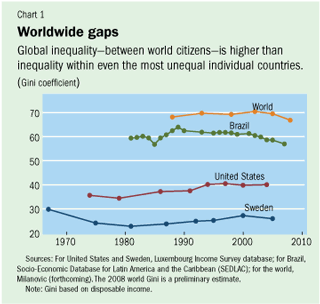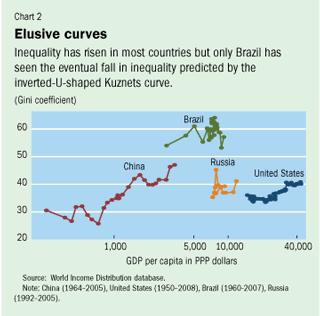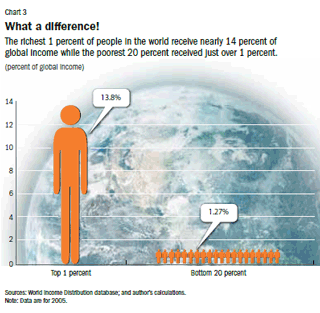More or Less
Finance & Development, September 2011, Vol. 48, No. 3
Listen to our podcast: The Rise of Inequality ![]()
Income inequality has risen over the past quarter-century instead of falling as expected

INEQUALITY is growing. Disparities are increasing—between the rich and poor in individual countries, and until recently, between countries. The global financial crisis is keeping real incomes stagnant in advanced economies but it probably narrowed global inequality between citizens of the world, because most developing countries continued with strong growth. Some say that inequality doesn’t matter as long as markets are working efficiently, or if everyone is getting more. Others argue that inequality hampers growth, or that only so much disparity is ethically acceptable.
Measuring up
How is inequality measured? People tend to compare their personal financial situation to that of their neighbors, coworkers, or friends, based on the homes they live in or the possessions they have. Economists usually use household surveys to measure income inequality. A broad spectrum of households is interviewed to determine their various sources of income (monetary and in-kind) and patterns of consumption. A household’s total income minus direct taxes paid (or alternatively, total household consumption) is divided by the number of people living in the household and then all individuals in the survey are ranked, from poorest to the richest, according to their household per capita income. This enables us to calculate what economists call the Gini coefficient (see Box 1).
Box 1. Let the Gini out of the bottle
The Gini coefficient is the most common measure of inequality. It ranges theoretically from 0, when everyone has exactly the same income, to 100 (or 1) when a single individual receives all the income of a society.
What are “normal,” “usual,” or “desirable” Gini values? The relatively egalitarian countries—Sweden and Canada, for example—have Ginis between 25 and 35. But the majority of countries are bunched around a Gini of 40. Today, the United States, China, and Russia all have Ginis in the low to mid-40s. Most African and Latin American countries have Gini coefficients in the upper 50s, and in some extreme cases and time periods, Ginis can even reach the low 60s. There are no confirmed and sustained cases of countries with Ginis that are any higher. So, the actual range of country-level inequality is 25 to around 60. And global inequality (between all citizens of the world) lies outside this range, at almost 70 (see Chart 1).
Although household surveys are the best instruments to assess incomes and their variability, they are not perfect. The upper end of the distribution may be “truncated”: either really rich people refuse to be interviewed for household surveys or they understate their incomes. The reasons for such evasion are not clear, given the confidentiality of household surveys. But suspicion of “upper-end truncation” has led to a recent wave of academic studies that instead use fiscal data—the reported pretax income of the rich—to estimate the income share of the richest 1 percent (or 0.1 percent) of individuals. The assumption is that the rich can less easily evade tax authorities than they can survey enumerators, and perhaps that they are more truthful when dealing with the former. But in fact, U.S. results based on surveys and those from fiscal data (Burkhauser and others, 2009) show little difference even though surveys look at the entire income distribution whereas fiscal data examine only the top.
Good or bad?
The view that income inequality harms growth—or that improved equality can help sustain growth—has become more widely held in recent years (see “Equality and Efficiency” in this issue of F&D). Historically, the reverse position—that inequality is good for growth—held sway among economists.
The main reason for this shift is the increasing importance of human capital in development. When physical capital mattered most, savings and investments were key. Then it was important to have a large contingent of rich people who could save a greater proportion of their income than the poor and invest it in physical capital.
But now that human capital is scarcer than machines, widespread education has become the secret to growth. And broadly accessible education is difficult to achieve unless a society has a relatively even income distribution. Moreover, widespread education not only demands relatively even income distribution but, in a virtuous circle, reproduces it as it reduces income gaps between skilled and unskilled labor.
So economists today are more critical of inequality than they were in the past. The advantages to reducing inequality are both practical—facilitating economic growth—and ethical—reducing unwarranted income disparities between men and women, between people living in different regions of a country, or between citizens of different nations. The past quarter-century has seen contradictory changes: while many types of inequality have increased (particularly those within individual countries), others became less pronounced.
Inequality on the rise
Income inequality has been on the rise—or stagnant at best—in most countries since the early 1980s (OECD, 2008). Often, this flies in the face of the two theories most commonly used to predict inequality: the Kuznets curve and the Heckscher-Ohlin-Samuelson (HOS) theorem (see Box 2).
Box 2. Theoretically speaking
The Kuznets curve, formulated by Simon Kuznets in the mid-1950s, argues that in preindustrial societies, almost everybody is equally poor so inequality is low. Inequality then rises as people move from low-productivity agriculture to the more productive industrial sector, where average income is higher and wages are less uniform. But as a society matures and becomes richer, the urban-rural gap is reduced and old-age pensions, unemployment benefits, and other social transfers lower inequality. So the Kuznets curve resembles an upside-down “U.”
The Heckscher-Ohlin-Samuelson theorem from international trade posits that as poor countries engage more in global trade, they tend to specialize in the production of goods in which they hold a comparative advantage, namely low-skill goods. Doing so should increase demand in the country for low-skilled labor and raise the wages of low-skilled workers relative to that of skilled workers. Using the skilled-unskilled wage ratio as a proxy for inequality, inequality should decline. The opposite should happen in rich countries: as they export more high-skilled goods, inequality would rise.
Income inequality in the richest countries (and in particular, those for which long-term data were the most plentiful—the United States and the United Kingdom) initially followed the Kuznets pattern of rising and then falling (not surprising, given that these observations inspired Kuznets to define the hypothesis). A massive and long downward swing in inequality occurred from its peak in the late 19th century in the United Kingdom and in the 1920s in the United States, to its lowest values in the 1970s.

But since then the United States and the United Kingdom—and indeed most advanced economies—have become much richer and much more unequal. In 2010, real per capita income in the United States was 65 percent above its 1980s level and in the United Kingdom, 77 percent higher. Over the same period, inequality in the United States increased from about 35 to 40 or more Gini points (see Chart 1), and in the United Kingdom, from 30 to about 37 Gini points. These increases reflect significant adverse movements in income distributions. Overall, between the mid-1980s and the mid-2000s, inequality rose in 16 out of 20 rich OECD countries. This coincidence of rising mean income and rising inequality in mature economies would no doubt have surprised Kuznets, as it did many economists.
Inequality also rose in China, a poor country with comparative advantage in unskilled labor–intensive products, whose trade-to-GDP ratio jumped from about 20 percent to more than 60 percent in 2008. The HOS theorem of globalization predicts that inequality would have fallen as wages of low-skilled workers relative to skilled workers rose. In fact, however, China’s Gini coefficient rose from less than 30 in 1980 to about 45 today. Once again, fact confounds theory.
Richer in the rich countries
What causes inequality? In rich countries, some economists argue, technological change, resulting in increasing demand for highly educated workers, is the reason that inequality is again on the rise. Societies haven’t been able to produce highly educated workers in the numbers needed in the new economy and as a result their wages have risen relative to their less-skilled counterparts. As the late Dutch economist (and first winner of the Nobel Prize in economics) Jan Tinbergen put it, inequality is the result of a race between technology and education. Although this favored the less skilled workers in the first decades of the 20th century, the requirements of the technological revolution again favored skilled workers.
In the United States, for example, Goldin and Katz (2008) find that the supply of skilled workers has been relatively fixed for the past three decades—the average number of years of schooling has been stuck at just over 12—and that, they argue, explains at least some of the increase in U.S. inequality.
This is plausible, if somewhat tautological, because we are unable to measure directly how much technological progress favors skilled workers. We can only deduce its strength from the gap between skilled and unskilled wages. But it is possible that an entirely unrelated force—say, the reduced power of trade unions—is in fact responsible for the rising skilled-unskilled wage gap.
A country’s institutional framework also plays a role in determining the level of inequality. Governments can use higher taxes and social transfers to redistribute some of the higher incomes earned by skilled workers. The more active redistribution in continental Europe may explain why inequality increased much less there than in English-speaking countries (Piketty and Saez, 2006). For example, in 2005, social transfers (exclusive of state pensions) and direct taxes reduced the Gini in Germany by 9 points but cut it in the United States by only 6 points.
A government’s refusal to take steps to minimize inequality may reflect its view that redistribution is wasteful and hurts market incentives (endorsing the argument that there is a strong trade-off between equality and growth). But failure to redistribute income may also reflect a political reality—that the rich wield a disproportionate influence over policy because they are more politically active and contribute more to politicians than their less affluent counterparts.
Recent political economy models of inequality assume that the “decisive voter”—one whose preferences tilt a decision one way or another—is much richer than the “median income voter.” Political decisions would then coincide much more with the preferences of the rich. In this analysis political systems have moved closer to “one dollar, one vote,” from the more traditional “one person, one vote” model (Karabarbounis, 2011).
Another explanation for increased inequality is changing social norms. In the past, society frowned on huge pay gaps between, say, a company’s chief executive officer and its workers. Now there are large gaps and they seem to be not only tolerated but encouraged (Levy and Temin, 2007). Although data confirm the widening gap, it is hard to pinpoint exactly which social norms have changed and why.
Globalization has also been blamed for the rising inequality in the rich world. Specialization in high-skilled exports leads to a rising gap between the skilled and unskilled wages. Moreover, cheap low-skill imports and outsourcing also reduce wages or increase unemployment among the low- or moderately skilled workers—further exacerbating inequality.
It is likely that all four explanations—technological progress, institutional change, changing social norms, and globalization—have had something to do with rising inequality in advanced economies. But even if impersonal forces like technology or globalization are the main cause, government intervention can still curb the increase in inequality.
Widening gaps in emerging markets

The story is not so different in developing countries. Even as the United States—the richest large country in the world—is one paradigmatic case of rising inequality, at almost the opposite end of the economic and political spectrum is China. China was (and still largely is) poor and has moved from being highly autarkic in the early 1980s to being highly exposed to international trade. Before reforms that began in 1978, China was universally poor, with a Gini under 30. As its economy grew in the years following 1978, China’s inequality surged and surpassed that of the United States (see Chart 2). Inequality increased in all its manifestations. The gap between the average urban and rural incomes is now more than 3 to 1 (compared with, for example, 2 to 1 in India). Gaps between the provinces widened as the coastal areas, which were richer to start with, grew faster than the hinterland. Wage inequality soared. And property and entrepreneurial incomes—always the most unequally distributed, and unheard of in China before the reforms—became much more significant.
But the Chinese story so far does conform to the classic Kuznetsian pattern: a poor country in the early stages of its development is likely to display rising inequality. If the country continues on the Kuznets path, we can expect a decline in inequality in the coming years. This could happen if the government were to extend social security to many more people (outside the state sector), or introduce unemployment benefits and possibly even a guaranteed rural employment scheme—as India did recently. It could also happen as coastal prosperity naturally extends into the central and western areas of China. Inequality is not the product of impersonal forces alone; it widens when society permits it and can be limited through conscious government policies.
Dramatic transitions
Post-communist countries experienced, with a few exceptions, the most dramatic increases in inequality. After the breakup of the Soviet Union in the early 1990s, inequality in Russia increased at a speed never recorded before anywhere. While U.S. inequality increased by approximately one-third of a Gini point annually between 1980 and 1995, in the decade following the end of the Soviet Union, the Russian Gini rose three times that fast. At the same time, real average income in Russia declined, often precipitously—creating a huge pool of newly poor.
The main force behind the increased inequality in the countries of the former Soviet Union was a privatization process that left enormous assets once part of the Soviet state in the hands of those close to the political power (the oligarchs) and created a strong division among the state-sector workers: the ones who remained employed and some who even prospered, and those who became unemployed, and whose incomes plummeted (Milanovic and Ersado, forthcoming). Social safety nets, which were often provided by companies, also collapsed. By the late 1990s, the growth in inequality ended; inequality in Russia has since remained slightly higher than in the United States—at a level similar to that of China.
In other post-communist countries, inequality increased too, although not as much as in Russia. In several Central European countries (Slovenia, Czech Republic, Slovak Republic) the new level of inequality was, judged by the standards of the current market economies, still relatively low. This was because they entered the post-communist transformation with highly egalitarian distributions of income, and even significant increases did not place them outside the levels continental Europe considered normal.
Latin exceptions to the rules
In key Latin American countries, by contrast, there has been a sustained decrease in inequality over the past decade (Gasparini, Cruces, and Tornarolli, 2011; see also “Spreading the Wealth,” F&D, March 2011). This was particularly noticeable for Brazil, which for decades was considered the classic high-inequality country. Brazil’s Gini dropped from the low 60s in 2000 to somewhere below 57 today—a striking difference given how much relative incomes need to change to effect a 1 Gini point decline or increase, how quickly the change took place, and how unique, compared with the rest of the world, it was (see Charts 2 and 3). Inequality also declined in Mexico and Argentina.
The improvements are often ascribed to social support programs such as Oportunidades in Mexico and Bolsa Familia in Brazil. But they are too big to be explained by the programs alone, whose size in terms of GDP is very limited (Soares and others, 2007). The changes in Brazil were also the result of broader access to education, which increased à la Tinbergen the supply of skilled workers. But even with these improvements, Latin American countries still exhibit some of the highest levels of inequality in the world. Brazil remains among the five most unequal countries in the world.
Round the world
If inequality within most countries either increased or remained constant over the past 30 years, does that mean global inequality must have increased too? The link is not so simple. Global inequality is the product not only of inequality within countries, but also of the gaps between countries’ per capita incomes. It is influenced by population and income sizes of the countries. China will affect global inequality much more than Luxembourg, for example. In determining what happened to inequality among all citizens of the world, we have to look at two contradictory movements: rising inequality within each country increases global inequality, but high rates of real income growth in poor countries, and especially in the gigantic countries like China and India, reduce global inequality.
The data for the calculation of global inequality come from individual countries’ household surveys, but they have to be complemented by an adjustment factor to convert national incomes into an international “currency” that has the same purchasing power in all countries of the world. The adjustment factor is the so-called purchasing power parity dollar ($PPP). Its main role is to adjust for differences in price levels between countries. Generally speaking, price levels in poorer countries are lower than in rich countries and, when we adjust for purchasing power, incomes in poor countries are higher than they would be if measured at market exchange rates. Using the most recent data on $PPPs, one can construct a global income distribution—a giant accumulation of individual survey data adjusted by country-specific PPP exchange rates—and calculate a worldwide Gini.

When we do this, at approximate five-year intervals for 1988–2005, we find that global inequality does not show a clear trend, but it is extremely high (see Chart 3), oscillating around 70 Gini points. This implies that the forces of (population-weighted) country convergence (namely, China and India catching up with the rich world) just about offset the forces of rising inequality within nations. But preliminary data for 2008—which reflect the much faster growth of emerging economies than advanced economies that continues today—suggest that lower global inequality could be ahead.
Global inequality seems to have declined from its high plateau of about 70 Gini points in 1990–2005 to about 67–68 points today. This is still much higher than inequality in any single country, and much higher than global inequality was 50 or 100 years ago. But the likely downward kink in 2008—it is probably too early to speak of a slide—is an extremely welcome sign. If sustained (and much will depend on China’s future rate of growth), this would be the first decline in global inequality since the mid-19th century and the Industrial Revolution.
One could thus regard the Industrial Revolution as a “Big Bang” that set some countries on a path to higher income, and left others at very low income levels. But as the two giants—India and China—move far above their past income levels, the mean income of the world increases and global inequality begins to decline. It is somewhat ironic that these hopeful developments coincide with the global financial crisis, but the very simple arithmetics of income and population show that the “decoupling” of economic growth between the rich world and emerging market economies has contributed to the decrease in global inequality.
Even in the middle of the crisis, and despite appearances, economics is not only about the “dismal” stuff. Decreasing global inequality, driven by high rates of growth and higher living standards of populous and still relatively poor economies like China and India, represents an epochal change: it reflects the newfound prosperity of millions of people. And as the world becomes more integrated, the political significance of lower global inequality may come to outweigh that of rising inequalities within nations. ■
Branko Milanovic is Lead Economist in the World Bank research group, a visiting professor at the University of Maryland School of Public Policy, and author of the recent book The Haves and the Have-Nots: A Brief and Idiosyncratic History of Global Inequality.
References
Burkhauser, Richard, Shuaizhang Feng, Stephen Jenkins, and Jeff Larrimore, 2009, “Recent Trends in Top Income Shares in the USA: Reconciling Estimates from March CPS and IRS Tax Return Data,” IZA Discussion Paper No. 4426 (Bonn, Germany: Institute for the Study of Labor).
Gasparini, Leonardo, Guillermo Cruces, and Leopoldo Tornarolli, 2011, “Recent Trends in Income Inequality in Latin America,” Economía, Vol. 11, No. 2, pp. 147–90.
Goldin, Claudia, and Lawrence Katz, 2008, The Race Between Technology and Education (Cambridge, Massachusetts: Belknap Press).
Karabarbounis, Loukas, 2011, “One Dollar, One Vote,” Economic Journal, Vol. 121, No. 553, pp. 621–51.
Levy, Frank, and Peter Temin, 2007, “Inequality and Institutions in 20th Century America,” MIT Department of Economics Working Paper No. 07/17 (Cambridge, Massachusetts: Massachusetts Institute of Technology).
Milanovic, Branko, forthcoming, “Global Inequality Recalculated and Updated: The Effect of New PPP Estimates on Global Inequality and 2005 Estimates,” Journal of Economic Inequality.
———, and Lire Ersado, forthcoming, “Reform and Inequality During the Transition: An Analysis Using Panel Household Survey Data, 1990–2005,” Economies in Transition: The Long-Run View, ed. by Gérard Roland (Houndmills, United Kingdom: Palgrave Macmillan).
Organization for Economic Cooperation and Development (OECD), 2008, Growing Unequal? Income Distribution and Poverty in OECD Countries (Paris).
Piketty, Thomas, and Emmanuel Saez, 2006, “The Evolution of Top Incomes: A Historical and International Perspective,” NBER Working Paper No. 11955 (Cambridge, Massachusetts: National Bureau of Economic Research).
Soares, Sergei, Rafael Guerreiro Osorio, Fábio Veras Soares, Marcelo Medeiros, and Eduardo Zepeda, 2007, “Conditional Cash Transfers in Brazil, Chile and Mexico: Impacts on Inequality,” IPC Working Paper No. 35 (Brasilia: International Poverty Centre).


